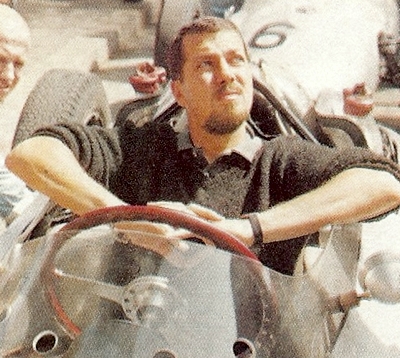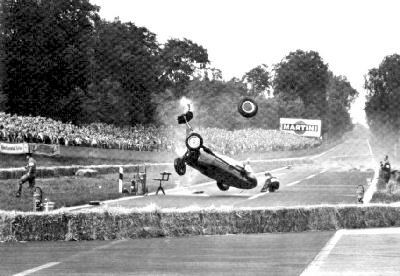Tragically, Joakim Bonnier was killed during the
1972 Le Mans 24-Hour race. Before his untimely death, he had established a long and distinguished motor-racing career which reached its zenith in 1959 when he joined the
BRM Formula One team and won the Dutch
Grand Prix for them.
Bonnier was one of the first Swedes to tackle motor racing seriously in the post-war years and led the way for other Swedish drivers like Ronnie Peterson and Reine Wisell. Bonnier was born in Stockholm in 1930, the son of a professor who ensured that his son had an international education in Paris and Oxford before taking up employment with his uncle's publishing business.
However, like so many young men born into a comfortable way of life, he forsook it all and instead spent three years in the Swedish Navy as a lieutenant, before taking up motor racing seriously. He had, in fact, been taking part in rallies since he was eighteen, specialising in the type of rough-road rallies at which the Scandinavians excelled.
Bonnier also took part in ice racing using Citroen and Alfa Romeo cars and it was his success with Alfa Romeo that prompted the Italian company to ask him to distribute their cars in Sweden. This naturally gave him access to the best competition cars from the Italian firm and he used a 3
½-litre Disco Volante Alfa Romeo to good effect, winning the 1955 Stockholm Grand Prix.
He also made his debut in England that year, taking the Disco Volante to a fine victory at Oulton Park, and this victory did much to bring his name to the attention of the British racing teams. In 1956, he became a full-time professional, running a privately owned 1
½litre Maserati in international events, albeit with little success.
He was then taken into the Maserati sports-car team for 1957 and in 1958 had his first real taste of Formula One, driving a 2
½-litre 250F. Unfortunately, this was the year that Britain's Vanwall team swept all before them and his only successes was in the Naples GP and the non-Championship United States GP.
For 1959, Bonnier was invited to join the hitherto unsuccessful
BRM team and promptly won for them the 1959 Dutch Grand Prix, a race which was also remarkable for the fact that every one of the starters finished the race and not a single pit stop was made. The Dutch victory was a flash in the pan for
BRM, however: although Bonnier stayed with them in 1960, he never finished a race in a higher position than fifth. In sports-car racing he was driving for Porsche and, as well as enjoying several minor wins, he co-drove the winning Porsche with Hans Herrmann in the 1960
Targa Florio race.
Bonnier raced the Porsche 1½-litre Formula One car in 1961 and 1962. Although the car was not fast he collected several third places. By the early 1960s it had become evident that Bonnier did not have the qualities to become World Champion, he lacked the sheer speed to win Formula One races; in sports-car racing, though, he was much in demand. From 1963 to 1965, Bonnier drove for the Rob Walker private team in Formula One races, first with a Cooper and later with a Brabham. His best placings in either of these cars were fifth places at Monaco,
Spa and Mexico.
However, in sports-car racing he continued to excel, winning the 1963
Targa Florio and the 1964 Reims 12-Hour race, with
Graham Hill, for Ferrari. He was second at Le Mans in 1964, again with
Graham Hill, in a 330P Ferrari, and won the Paris 1000-Kilometre race at Montlhery. When Formula One changed to 3-litres in 1966, Bonnier was obliged to buy his own car to remain in top-class motor racing. He purchased a Cooper-Maserati, which was uncompetitive even in faster hands than Bonnier's, and his best placing in 1966 was sixth at Mexico.

 Bonnier gets airborne in a BRM, but this is not the accident Bonnier gets airborne in a BRM, but this is not the accident
that would claim his life. |
The following year he scored a fifth place in the
German Grand Prix and sixth in the United States GP. His sports-car prowess remained, however, and he drove the American Chaparral in 1966, winning the
Nurburgring 1000 km race, with Phil Hill as his eo-driver. For 1968, he tried a Formula One McLaren-
BRM, but had little success during the year, apart from 6th place at the Italian GP. He was given a drive in the Honda V 12 Formula One car at Mexico that year and finished sixth.
He purchased a Lotus 49 for the 1969 season and looked forward to a more successful year but crashed the car at Oulton Park and never raced it again. He switched to a McLaren M7C for Formula One but by 1970, at the age of 40, he was not at all competitive against younger men in newer machinery and he wisely retired from single-seater racing that year, making the grand gesture of hanging his McLaren on the sitting room wall of his home in Lausanne, Switzerland.
Like so many drivers before him, he could not forsake the wheel, so he switched to the new 2-litre European Sports Car Championship with a Lola, and on many occasions showed younger men that his skill had not gone, by notching up victories at several European tracks.
For 1972, he purchased two of the new 3-litre Lola T280 sports cars, with which he planned to tackle the World Sports Car Championship. The cars proved to be very fast but rather fragile and ill-maintained. He managed to win the mini-Le Mans four-hour race in 1972 and led in the early stages of the 24-Hour race. He dropped to eighth in the early hours of Sunday morning but started to make up time rapidly, after a pit stop with brake problems.
Bonnier was lapping a Ferrari Daytona when the two cars collided and the tiny Lola shot over the safety barrier into the trees lining the track at Indianapolis corner. He was killed instantly. Bonnier's main claim to a place in the history of motor racing is not for his racing record, excellent though it was, but for his ability as an international diplomat, pleading the cause of motor racing safety and advancing the image of
Grand Prix drivers from that of glorified playboys to international stars.
Founding The Grand Prix Drivers' Association
He founded the
Grand Prix Drivers' Association, in 1962, and was its chairman until he died, leading the fight for drivers' rights. With his fluent command of six languages and aristocratic bearing he added a lustre to the sport of motor racing. Joakim Bonnier lived and died for his sport; he will never be replaced.
Bonnier at work in his own Lola T280 3-litre sports car, during the 1972 Le Mans 24-hour race.
Early on Sunday morning, the car left the track and Bonnier was killed.



